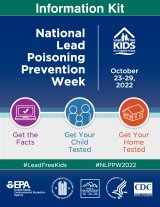Get Ready for National Lead Poisoning Prevention Week!
“I didn’t know lead was still a problem,” is something I will never forget hearing a few years ago when I was working on the Lead Awareness in Indian Country: Keeping our Children Healthy! Curriculum with our tribal partners. In fact, I continuously hear from people that they think lead is no longer a problem or that lead exposure isn’t something they need to worry about anymore.
The sad truth is that lead is still a problem for our children. Lead can be found in the paint on our walls, in our plumbing fixtures, in the soil and in many products like painted toys, furniture, and jewelry. Lead exposure to children today can have lifelong impacts on their health.
No safe blood lead level in children has been identified. When lead is breathed in or swallowed by children, it can result in damage to the brain and nervous system, learning and behavior problems, slow growth and development, and hearing and speech problems. Even low levels of lead in blood can hurt a child’s ability to learn, do well in school, or pay attention throughout their life.
As a member of EPA's Lead-Based Paint Outreach and Engagement team and an aunt to four awesome little kids, I understand how overwhelming learning about lead and lead exposure can be. There is a lot of information out there and the impact lead can have on your child’s health can be distressing.
However, childhood lead exposure and lead poisoning is preventable! Once we acknowledge that lead is still a problem, simple actions can help prevent lead exposure. These actions also benefit the overall health of our land and our families.
Preventing Lead Exposure Starts at Home

Young children crawl and play close to the ground making them more likely to come into contact with dirt and dust, which can include lead. They also often put their hands, toys, and other items in their mouths. Here are some simple actions that you can take to reduce children’s lead exposure.
- Wash your hands several times throughout the day.
- Clean with wet cloths instead of dry ones.
- Regularly wash toys.
- Take off and wipe your shoes before going inside.
- Hire lead-safe certified contractors to do renovations.
Let’s Talk about Lead During National Lead Poisoning Prevention Week

For the past 40 years, EPA and other federal agencies have made significant progress in reducing lead exposure by banning its use in many products, including gasoline, residential paint, and plumbing fixtures. As a result, we have seen an overall decline in children’s blood lead levels. Over the years, EPA has worked with other federal agencies to reduce childhood lead exposure and educate the public about preventing lead exposure and lead poisoning. This includes our current work with the Centers for Disease Control and Prevention (CDC) and the U.S. Department of Housing and Urban Development (HUD) to develop materials, events and activities in preparation for National Lead Poisoning Prevention Week (NLPPW), which has been observed during the last full week of October since 1999.
I am proud of the work we are doing and encourage you to join us in spreading awareness about lead and NLPPW, which is October 23 – 29 this year.
Learn about Lead and Spread the Word
You can start by learning more about lead and lead poisoning prevention:
- EPA's NLPPW 2023 Information Kit (pdf) (Updated)
- Protect Your Family pamphlet (available in 12 languages)
- EPA's Learn about Lead webpage
Once you’ve learned a little more about lead and lead exposure, share what you’ve learned with others during NLPPW. There are many ways to share what you’ve learned. You can:
- Share posts on social media using the sample posts and content ideas in the NLPPW 2023 Sample Social Media Package (pdf) (Updated), making sure to use the hashtags #LeadFreeKids and #NLPPW2022.
- Facilitate an educational event (webinar or in-person) before or during NLPPW using the modules in the Lead Awareness Curriculum developed in collaboration with our tribal partners.
- Incorporate lead poisoning prevention activities into a related, existing community event.
- If you’re a contractor, attend one of our free training sessions on lead-safe work practices. If you’re a DIYer, check out our resources on lead-safe renovations.
- Connect your NLLPW events and activities to other events and activities taking place in October during Children’s Health Month.
Join Us!
Join the NLPPW 2022 conversation on social media by following us on Twitter (@EPA, @EPAChemSafety and @EPAenespañol), Facebook (EPA and EPAenespañol) or Instagram (@epagov). Over the next couple of weeks, we will be sharing information and resources, as well as events and activities EPA, CDC and/or HUD have planned.
And of course, don’t forget that lead exposure and lead poisoning are preventable. It’s up to us to take action now to protect the children in our lives from lead exposure. Please join us in spreading the word about lead poisoning to help ensure families and communities across the U.S. have the information they need to prevent childhood lead exposure and lead poisoning.

About the Author
Shayna Sellars
Environmental Protection Specialist
Office of Chemical Safety and Pollution Prevention
Shayna coordinates the outreach and engagement for EPA’s Lead-based Paint Program within the Office of Chemical Safety and Pollution Prevention. She works closely with EPA’s regional offices, CDC, HUD, and community partners to develop educational materials and implement outreach, such as National Lead Poisoning Prevention Week, EPA’s Enhancing Lead-Safe Work Practices through Education and Outreach initiative and the Lead Awareness in Indian Country Keeping our Children Healthy! curriculum.
Editor’s Note: The views expressed here are intended to explain EPA policy. They do not change anyone’s rights or obligations. You may share this article. However, please do not change the title or the content, or remove EPA’s identity as the author. If you do make substantive changes, please do not attribute the edited title or content to EPA or the author.
EPA’s official web site is www.epa.gov. Some links on this page may redirect users from the EPA website to specific content on a non-EPA, third-party site. In doing so, EPA is directing you only to the specific content referenced at the time of publication, not to any other content that may appear on the same webpage or elsewhere on the third-party site, or be added at a later date.
EPA is providing this link for informational purposes only. EPA cannot attest to the accuracy of non-EPA information provided by any third-party sites or any other linked site. EPA does not endorse any non-government websites, companies, internet applications or any policies or information expressed therein.
